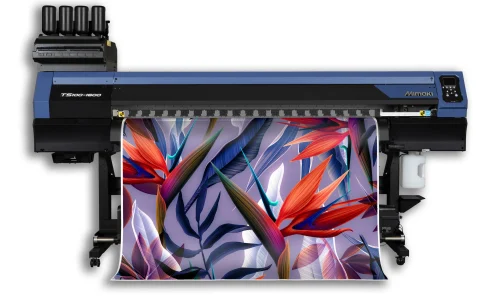How Printing Technology Is Revolutionizing Fabric Customization

Speed and quality are everything in the business of clothing production and bespoke apparel. For a small bespoke t-shirt shop or high-volume fashion enterprise, the ability to create intricate, durable prints quickly is changing product production. Added to the list of the most exciting technologies that make that possible is Direct-to-Film (DTF) printing—a process that brings together digital precision, smart materials, and heat science.
It’s not a fad, DTF is a new direction of modern textile technology. Thanks to special films, inks, printers, and heat presses, businesses like Bowen Material are making available the equipment that’s changing the way clothing and fabric is being customized today.
What is DTF Printing?
DTF stands for Direct-to-Film. It is one technique of printing in which a pattern is printed on transparent film and heat-pressed onto fabric. It stands apart from the messy, time-consuming process of screen printing, or the cotton-exclusive process of direct-to-garment (DTG) printing, because DTF is simple and versatile.
The DTF process works in several steps:
- A print is produced with the help of special DTF ink on printable DTF film.
- A powder adhesive is sprayed over wet ink.
- The film is heated slightly to melt the adhesive.
- It is then transferred to fabric using a heat press machine.
- When pressed, the film is peeled off, and the design is left on the materia
Each step is so easy, yet there is a lot of science and precision engineering that goes into it.
The Science Behind the Materials
We will start with the DTF films. They are not just plastic sheets. They are made to accept ink without smudge, have a clean release design, and withstand heat and pressure in transfer. They must possess an ideal balance of texture, clarity, and thermal resistance.
The ink used in DTF printers also plays an important part. It consists of pigment particles in a liquid base form. They release deep, washfast colors that adhere to fabric even after washing. The trick is to maintain the ink sharp on the film, melt sufficiently with the adhesive, and then adhere to fabric fibers permanently
Finally, the powder adhesive applied to the design before pressing is a heat-activated adhesive. It needs to melt nicely when pressed and set as a flexible bond that stretches with the fabric. This is important to maintaining long-term comfortable prints.
Application of Heat Press Machines
The heat press is where everything comes together in the DTF. It must put just the right pressure and temperature to melt the glue and transfer the image. Too hot, and you burn the fabric. Too cold, and the image won’t adhere.
New heat presses also have electronic controls for pressure, temperature, and time. These high levels of accuracy ensure that prints are identical from shirt to shirt—a necessity for professional production.
Bowen Material offers presses specifically designed to meet the exact needs of DTF transfers. For small runs or mass production, they allow the user to produce clean, sharp prints with little waste.
Keeping the System Clean and Efficient
As with any premium printing technology, DTF printing is dependent upon having equipment properly cleaned and serviced. Ink and adhesive can adhere to printheads, rollers, and other parts over time, and this affects quality.
This is where cleaning products like the DTF cleaner are useful. They are designed to dissolve dried ink and residue without harming the printer’s delicate components. Daily cleaning maintains the colors vibrant and the machines in good working order.
Cleaning is especially important when printing with pigment inks, which may clog nozzles if not printed after some time. A good cleaner prolongs the printer’s life and pays off in the long term.
Benefits of DTF compared to other printing technologies
DTF printing is special because it offers one-of-a-kind speed, flexibility, and compatibility with fabric. Here’s why it’s gaining popularity so quickly:
- Prints on nearly all substrates:Unlike DTG, which favors cotton the most, DTF prints on polyester, blends, nylon, and so many others.
- Increased durability:DTF prints withstand numerous washing cycles without cracking or discoloring.
- Vibrant, sharp colors:The pigment ink and smooth-film surface provide high-resolution output.
- Simple storage and repro:DTF printed film can be stored and later shipped, which is convenient for batch runs.
This makes DTF a perfect solution for businesses that require high-quality, customized prints without the limitations of conventional techniques.
Applications Across Industries
DTF printing does not apply only to t-shirts. It is applied to print:
- Customized jackets and uniforms
- Sportswear and team uniforms
- Marketing tote bags
- Fashion items with detailed graphics
- Event branding and merchandise
With the right material and equipment, small businesses can make professional-grade products at reasonable prices and with ease. Bowen Material offers a wide range of DTF printing materials for all such applications.
Towards More Sustainable Printing
Another exciting feature of DTF printing is its potential as a green alternative. It uses less water than screen printing, and fewer toxic chemicals are being found to be used in new adhesives and inks.
And, furthermore, printing only what is needed eliminates waste. Conventional printing usually leaves surplus stock or wrong prints. DTF’s on-demand strategy facilitates a low-stock, high-personalization strategy that aligns with current sustainability objectives.
The Future of DTF Technology
With the growing need for personalization, the need for more intelligent, fast, and clean printing systems will also increase. Researchers and manufacturers are already creating:
- Rapid-curing inks
- Self-cleaning printer parts
- Smart temperature sensors for heat presses
- Computer-aided design software to automate the workflow
For the consumers, it means more results with less effort.
Conclusion
DTF printing is a craft more so than an art form—it’s chemistry, engineering, and design. From printable films to heat presses and cleaning solutions, each component is built to complement the other.
Companies like Bowen Material are giving printers, designers, and makers the power to reach new levels of liberty and quality. As technology improves, DTF printing will be at the forefront of a new trend—where anyone can bring a digital design to life, wearable, and lasting.
Whether you’re creating your initial tee or starting a print business, DTF shows just how advanced the science of printing has become—and where it’s going next.

Source: How Printing Technology Is Revolutionizing Fabric Customization




